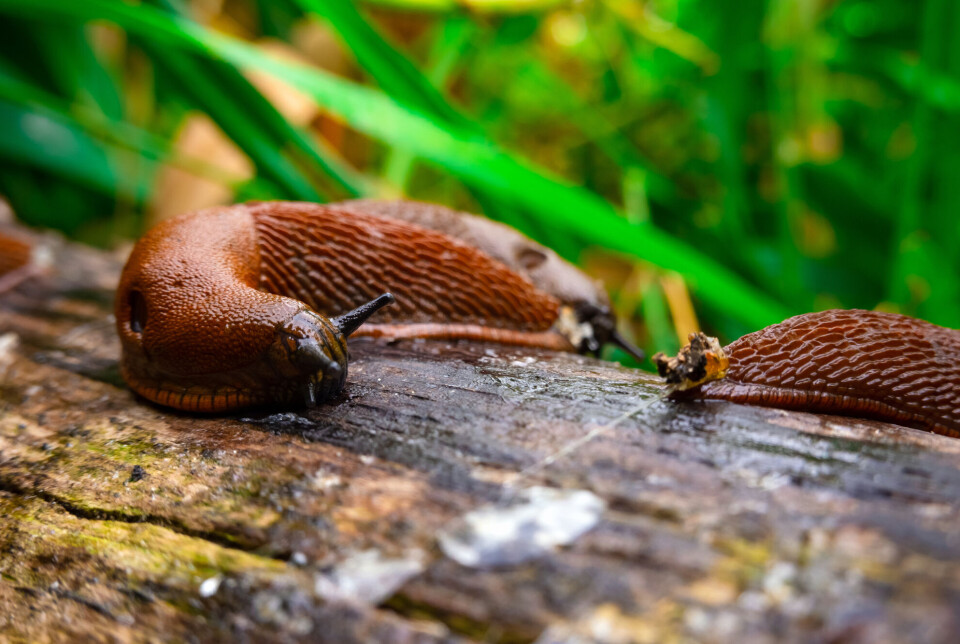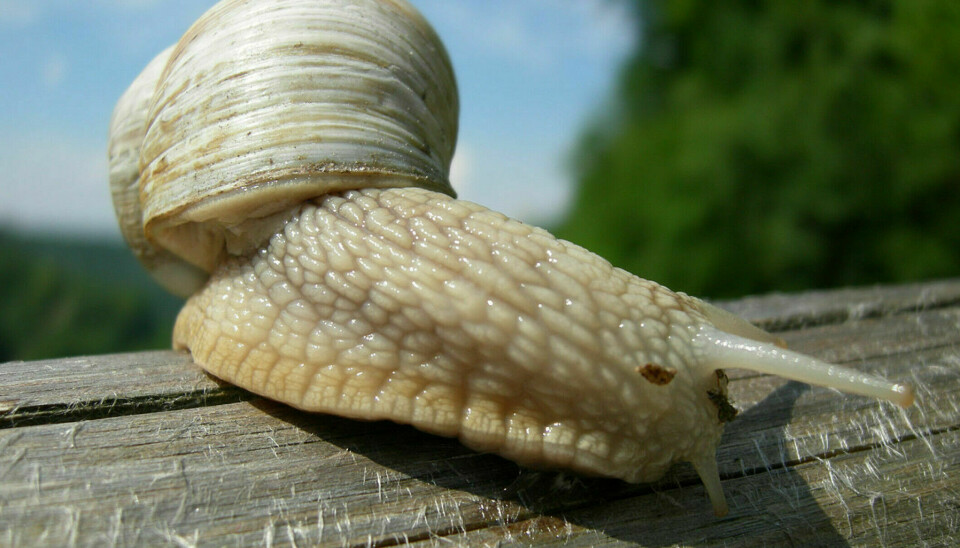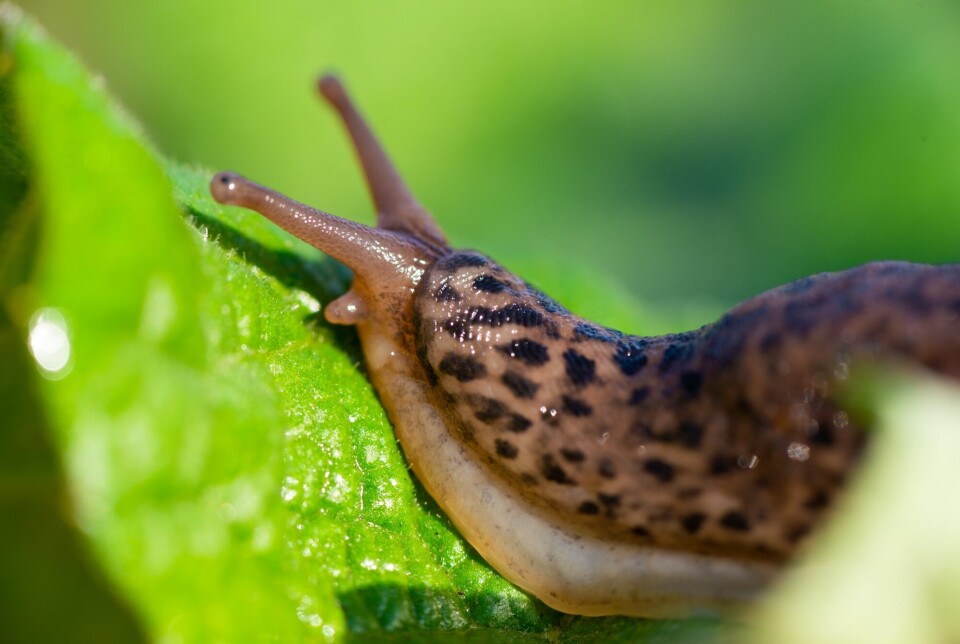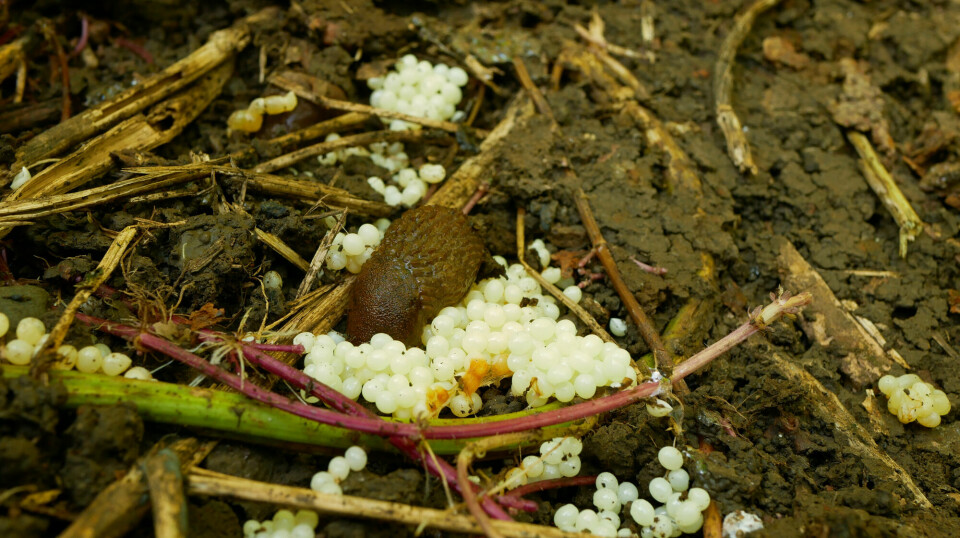
The secret lives of slugs: Where do they hide and why do the come out after rain?
A wet summer is not necessarily the best for the much detested Spanish slugs.
The grass is damp, and the slugs are on the move again.
Why are slugs especially active when it has rained? And where do they keep themselves when they are not out in the open?
Bjørn Arild Hatteland is a researcher at the Norwegian Institute of Bioeconomy Research (Nibio). Some of his work has been with slugs.
He tells us why they thrive in moist environments. The reason isn’t terribly surprising, considering the slimy properties of slugs.

Protective house
Slugs need damp environments “simply because their problem is that they can dry out, especially slugs that don’t have a house on their back,” says Hatteland.
They really depend on finding a place to hide when it gets dry outside.
Slugs with houses – or snails – on the other hand, carry their own hiding place with them. You can sometimes see them hanging on a wall in the mid-day sun.
“Snails are typically smaller and not as easy to see,” says Hatteland.
And yet, snails live in the harshest environments.
In a scientific article from 1971, the researchers write that some desert snails only die when they are exposed to temperatures of 50 to 55 degrees Celsius for longer periods.
In the heat they hibernate, while during the more humid winter they eat and mate.
Other snails are able to cope well with the cold.
Found above tree line
If you didn't think of slugs as mountain dwellers, Hatteland has news for you:
“You can find slugs at elevations of 1200 to 1300 metres above sea level. Some of them can withstand a lot of cold. We're talking about well below 0 degrees.”
When the temperature drops below zero, the slugs go into a kind of hibernation, somewhat in the same way as other insects and small animals, the researcher says.
“Some slugs use a kind of antifreeze in their bodies so that they don't have too much ice build-up. Other species supercool themselves and can tolerate ice forming between the body's cells.”
They are inactive when it gets too cold, but on a mild winter's day along the coast you might come across an active slug. According to Hatteland, they don’t need more than a few degrees above freezing to take advantage of the opportunity to eat something.
Then they find their way back to their cosy hiding places when the cold returns.
Where are the slugs when we don't see them?
But where do slugs go when we don't see them crawling around after a rain and at night?
“They hole up in cavities in the ground, in taller vegetation and other places that retain humidity,” says Hatteland.
Small slugs, for example, can burrow a bit into moss or the top soil layer. They also stay there in the winter.
Some slugs have fixed hiding spots, says Hatteland.
“A lot of slugs return to the same hiding places when the day dawns and it starts to get dry.”
The Roman snail is used in the popular escargot dish in France. It has been released and is spreading in some places in Norway as well, although it is unwanted here.

Smells its way to food
The slugs with a fixed spot have a home range that they stay within when they move around to find food.
You can see that for yourself in your own garden. Woodpiles or compost piles are often favourite places for the slugs to seek shelter.
“Then you can follow them and possibly combat them,” says Hatteland.
“They don't have very good vision, but can detect light and tell whether it’s cloudy or sunny. They signal where they are and largely use their sense of smell. They can also smell their way to flowers and plants that they want to eat.”
With the help of slime trails, slugs can find their way to members of their own species, such as happens when slugs have their mating season.
Mostly plant and mushroom eaters
We don't know much about the slugs' social life otherwise, says Hatteland.
Slugs sometimes gather in large numbers in the same place, but probably not because they seek each other's company.
“They’re not social in the same way that certain insects are. They’re looking more for the same things, like food or a place to hide.”
That is, except for the aggressive ones, like the leopard slug or giant garden slug. They deliberately go after other slugs to chase them away. Other species prey exclusively on other slugs.
Otherwise, slugs are largely herbivores, says Hatteland.
“Many slugs prefer slightly weakened or withered and dying plants. They act as decomposers.”
Other species of both slugs and snails have other food preferences. They opt for mushrooms, lichen and moss.

Hard to predict Spanish slug occurrence next year
Slugs like
moisture, but the summers can get too wet, especially with torrential rain.
“Flooding isn’t good for air-breathing slugs. They shouldn’t be down in the water,” Hatteland says.
During the last decades the Spanish slug has invaded large parts of Northern Europe, causing frustration for many a gardener. The next generation of Spanish slugs are hatching in the late summer, and autumn and winter will impact how many survive.
You can also affect the population by making your garden less slug-friendly.
Piles of grass or plant debris in your garden are good places for brown slugs to lay their eggs.
You might find the egg clusters when you clean up the garden. The eggs are white and about half a centimetre wide. Each cluster can consist of about 20 to 60 eggs.
After their late summer egg-laying, most adult slugs die.

Still spreading
In the long term, slugs are certainly likely to spread even more, and Spanish slugs are now found all the way above the Arctic Circle in Northern Norway, says Hatteland.
Spanish slugs can be present even if you don't see them: in dry periods it can look like they are pretty well gone. Then it gets damp and it can look like an invasion.
Admittedly, conditions vary from season to season. Nevertheless, Hatteland does not expect that places that already have Spanish slugs will see any dramatic increase.
“We can expect them to establish themselves further inland and north,” says Hatteland.
———
Read the Norwegian version of this article at forskning.no
































